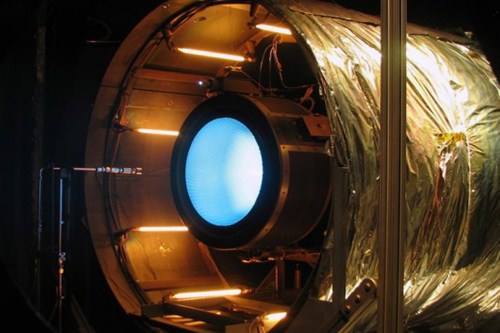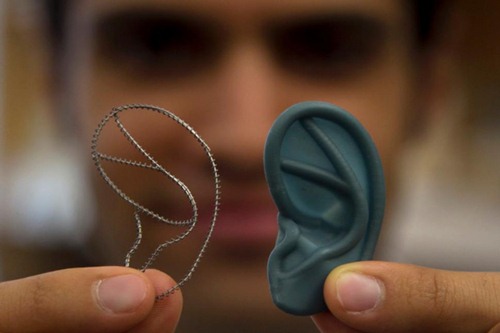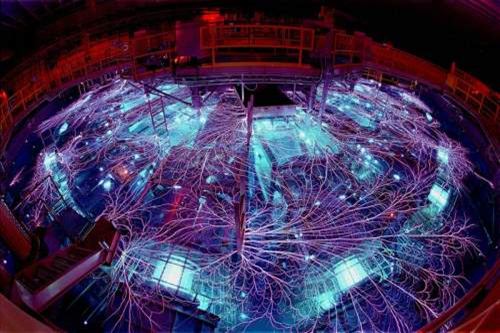In the last decade or so, we’ve all heard about advancements and inventions such as the Curiosity rover on Mars, and self-driving cars. But here are 11 technologies that sound straight out of an Issac Asimov novel, except they actually exist. Read on, to find out more about death rays mounted on navy ships and bullets with minds of their own. 11 technologies that will surprise you:
11. Hoverboards

Countless engineers and researchers at the car maker Lexus put their collective minds together and managed to create, of all things, a working hoverboard! The SLIDE hoverboard is powered by magnets and superconductors cooled by liquid nitrogen. It works on more or less the same principle as a maglev train, which uses super cooled powerful magnets to float above the rails.

In this case, Lexus built an incredibly expensive custom skate park in Barcelona, Spain, with lots and lots of magnets built into the ground.
Unfortunately, there’s no way it will be coming to a skate park near you anytime soon, as the SLIDE hoverboard isn’t for sale, and convincing your city council to build a very expensive skate park with lots of expensive magnets built into the ground would be an exercise in futility. The hoverboards are one of the technologies that will surprise you.
10. Helicopters Turn into Planes Then Back into Helicopters

Ranking among the technologies that will surprise you, the Bell Boeing V-22 Ospreytiltrotor aircraft is, basically, an aircraft that takes off and lands like any old garden-variety helicopter, but in flight it turns into a turbo-prop aircraft, by tilting its engines forwards to act like a normal aircraft engine. According to Boeing’s website, “With its rotors in vertical position, it can take off, land and hover like a helicopter. Once airborne, it can convert to a turboprop airplane capable of high-speed, high-altitude flight.”
It has a cruise speed of 446 km/h, compared to the Chinook helicopter’s cruise speed of 240km/h, and it has a far longer range than contemporary helicopters, being able to send up to 32 combat-ready troops to anywhere within an a 722 kilometer radius.
To quote a Marine general, the Osprey “turned a battle space that was the size of Texas into the size of Rhode Island.” It has entered service with the United States Marine Corps, United States Air Force, doing everything from carrying soldiers around Afghanistan, and evacuating injured soldiers from combat zones.
9. Bionic Limbs – technologies that will surprise you

Artificial limbs have existed for years, from olden wooden peg legs (think pirates) to the clunky prosthetic Terry Fox used on his cross-country fundraiser run. They were heavy and stiff, but fast-forward into the 21st century, we have ultra-light limbs made out of carbon fiber and titanium that cost up to a cool $45,000, and we now have bionic legs that can be controlled with your mind.
Gudmundur Olafsson lost his lower leg as a child when he was hit by a truck, but now he has been fitted with a modified robot foot made by the Iceland based company Ossur, which he has been using daily for more than a year that can move on command like a real foot. A minimally invasive 15-minute long surgery was performed to implant sensors in his residual limb. The star of the prosthesis is the robot ankle, which moves based on which sensor picks up an impulse in local muscle tissue. If Gudmundur flexes his calves, the robot foot mirrors him.
“It’s really surreal,” he says. “The first time, to be honest, I started to cry. You are moving the ankle, and I basically haven’t had one in 11 years.” It allows him to redistribute his weight evenly, and to stave off muscle atrophy that is common in amputees. No one’s sure when’s it’s going to come out, or how much it would cost, but fully-functioning minimally-invasive robot legs would give many people a new lease of life, and maybe in 50 years we would be able to swap our puny flesh arms for carbon-fibre robot arms.
8. Invisibility Devices – Technologies That Will Surprise You

In the Crysis games, you play a super Soldier in a suit who can turn invisible and toss aliens like Hacky Sacks. Outside of video games, scientists at the Dallas NanoTech Institute used sheets of carbon nano tubes, which are one-atom thick sheets of carbon rolled up into microscopic tubes, to bend light around the sheets, effectively cloaking them.
The key to the technique they used is the same effect that causes dying travelers in the desert to think an empty patch of land is an oasis, the mirage effect. The temperature difference between sand and air bend light rays, directing the light rays towards the hapless traveler’s eyes instead of bouncing them off the surface. This makes a “puddle of sky” on the ground, which any desperate dying traveler would think is water.
The carbon nano tube sheets were immersed in water and heated up, which also heated up the water, which caused light to bend away from the sheet , and obscuring whatever was behind the sheet. It’s impractical as a military cloaking device as you would have to wear a super-hot suit that has to be immersed in water, but it’s certainly cool as hell.
7. Electromagnetic Railguns – Technologies That Will Surprise You
In our list of technologies that will surprise you there’s a thing called electromagnetic railguns. Remember that scene in Transformers: Dark of the Moon, where Agent Simmons calls in a “railgun” strike from a destroyer on a giant Decepticon on the Pyramids of Giza?
For the uninitiated, a railgun is a basically a bunch of magnets used to propel a projectile. Small scale railguns have existed in universities, but the US military managed to build one that, according to a US Navy officer, impacts like “a freight train going through the wall at a hundred miles an hour.”
After years of research, the United States Navy unveiled a real-life rail gun in February at its Science and Technology Expo that can fire projectiles at seven times the speed of sound, and it can hit targets 110 miles away. Even better, a rail-gun has been fitted on the USNS Trenton for test purposes. Construction of combat-ready rail-guns for the next generation US Navy combat ships are projected to begin in 2028. If all goes to plan, missiles and shells might be obsolete in the next century or so, who knows?
6. Laser Weapons – Technologies That Will Surprise You
We don’t anything that’s anywhere near the awesome destructive power of the Death Star in Star Wars, but the US Office of Naval Research has developed the currently operational Laser Weapon System (appropriately shortened to LaWS-do they have a special committee that comes up with all these cool names?) which has been installed on the USS Ponce since 2014. Sailors on the ship carry out regular exercises with the laser, and even have destroyed targets with it. What job comes with the opportunity to destroy things with lasers?
The LaWS is 6 normal-ish lasers combined into one death ray with a power of 30 kilowatts, and has the ability to roast UAVs and boats for $59-cents per shot, which is way way cheaper than a $759,000 missile that you can only use once. There are also are other lasers such as Lockheed Martin’s Area Defense Anti-Munitions (ADAM) system, which defends against incoming projectiles, and Boeing’s 10kW High Energy Laser Mobile Demonstrator. Laser Weapons, may very well be among technologies that will surprise you but, someday it’s going to be a reality.
5. Ion Engines
In the Star Wars trilogy (the original trilogy, mind you!), the ubiquitous TIE fighters of the evil Empire are powered by twin ion engines, hence the name TIE. You may be surprised to learn that ion engines do exist outside of science-fiction, though they are no where nearly as powerful as shown in movies. The Dawn spacecraft takes 4 DAYS to go from 0-60mph! Ion Engines are one of those technologies that will surprise you but really do exist.
The boffins at NASA managed to create a working prototype of an ion engine in 1959, and they bolted it on to the Deep Space 1 and Dawn space probes. The Deep Space 1 probe traveled total of 263 million kilometers at a maximum speed of 4.5 kilometers a second, and the new HIPEP thruster, under development at NASA, has exhaust velocities at over 90 kilometers a second.
Ion thrusters work by expelling an inert gas (remember high school chemistry?) at high speed to get a small amount of acceleration. Even though the thrust produced is rather small, craft with ion engines can reach very high speeds because ion engines produce a small thrust for a long time.
4. Bionic eyes – technologies that will surprise you
It might sound like something out of The Six Million Dollar Man, but scientists have managed to fit Ray Flynn, an 80-year old British man with the most common form of blindness, Age Related Mascular Degeneration, with the Argus II implant (which costs a cool $150,000) in June. Amazingly, he was able to immediately see the outlines of people and objects with his eyes closed when the device was switched on, and his eye doctor, Dr Paulo Stanga is optimistic that it will only improve with time.
The Argus II, made by Second Sight Medical Products, which is based in California, works by converting a video feed from a camera attached to his glasses to signals that are sent to tiny electrodes attached to undamaged cells in his retina, the part of the eye that detects light and sends it to the brain. The undamaged cells are then stimulated and send signals to the brain. The Argus II is one of those technologies that will surprise you but is approved for marketing in the European Union, and is approved under a ‘humanitarian device exemption’ in the United States.
3. Self-Guiding Bullet – Technologies That Will Surprise You
Real-life sniping, unlike in Call of Duty, requires one to do take into account factors such as range, bullet drop, gravity, wind speed, humidity, and even the rotation of the Earth, along with movement of the target and the inevitable delay between firing and impact . In the future, snipers may just have to point a red-dot at a target and pull the trigger, as the geniuses at the Defense Advanced Research Projects Agency (DARPA) pulled another rabbit out of their magic hat, the EXACTO (Extreme Accuracy Tasked Ordnance- Who comes up with these names?) Self-guiding bullet, which is a modified .50 cal bullet.
That’s right, A SELF GUIDING BULLET – this is one of those technologies that will surprise sou. That can turn in mid-flight. The specifics of the system are (obviously) classified so damned high that you’ll need a telescope to see them, but among the EXACTO system’s abilities are the ability to knock down targets at 2000 meters, and to make sharp turns midflight. And it can also hit moving targets, whether fired by a trained marksman or a novice shooter.
It uses some kind of guidance system (powered presumably by magic or clippings of Chuck Norris’s beard, as it’s classified) to allow for weather and other factors that might make it miss the target. Imagine bullets that can swerve around obstacles to hit objects (e.g. people) behind them. Should we be awed, terrified, or both?
2. Organs Grown In a Lab
In the distant future, humans might not need to worry about trivial things like organ failure. Researchers at the University of Edinburgh in Scotland have managed to grow a whole functioning organ in an animal, in this case mice. They managed to trick cells from a mouse embryo into thinking they were supposed to grow into a thymus, an organ which is part of the immune system. The cells were then injected into lab mice, which then grew into a fully functional thymus. Unfortunately, they haven’t figured out how to apply the same technique to humans.
There are also lab-grown blood vessels, windpipes and bladders. Scientists made scaffolds which were then “seeded” with the patients’ own cells, which were then implanted into the patients. A custom titanium rib cage has also been created for a patient in Spain. Who knows, maybe in a hundred years we would be able to simply custom order organs and swap them out. Let’s hope that science stays on the right track for this particular field of research.
1. Fusion Reactors
At number one in our list of technologies that will surprise you is the Fusion Reactor. Fusion reactors, like the European JET Tokamak reactor, and the ITER reactor under construction, harness the same reactions that happen in a SUN to generate electricity. It may sound unbelievable to many. In the Sun, hydrogen atoms collide, and then they fuse into heavier helium atoms, giving off incredible amounts of energy in the process.
On Earth, a fusion reaction between two hydrogen isotopes, deuterium and tritium, is utilized to generate energy. For the reaction to occur, a temperature 10 times higher than the temperature at the Sun’s core is needed. At these temperatures, the electrons are separated from nuclei and make a very hot, electrically charged gas called plasma.
The plasma is contained using giant magnets, and neutrons produced by the reaction will be used to generate heat to turn turbines, converting it to electricity. This might sound like a lot of trouble to generate electricity, compared to already mature technologies like fossil fuel plants, but fusion reactors only give off helium, and minimal radioactive waste that can be recycled in a 100 years, as by-products.
Helium is a gas which doesn’t do very much chemically, and is used to fill up floating balloons, and waste radioactive waste from fusion reactors is far less nasty than from fission reactors. Coal plants and their fossil fuel utilizing brethren give off incredible amounts of greenhouse gases, contributing to global warming.
Fusion reactors represent the future of clean energy production for our race, as we have to meet rising energy demands from a growing population without making pollution worse than it already is. Companies such as Lockheed Martin are currently working on compact fusion reactors that can be used in really cool applications such as going to Mars (we’re looking at you Elon Musk, make it happen!) and making aircraft that can fly for a year without refueling.
11 Technologies That Will Surprise You
- Fusion Reactors
- Organs Grown In a Lab
- Self-Guiding Bullets
- Bionic eyes
- Ion Engines
- Laser Weapons
- Electromagnetic Railguns
- Invisibility Devices
- Bionic Limbs
- Helicopters Turn into Planes Then Back into Helicopters
- Hoverboards
Please rate this artcle













